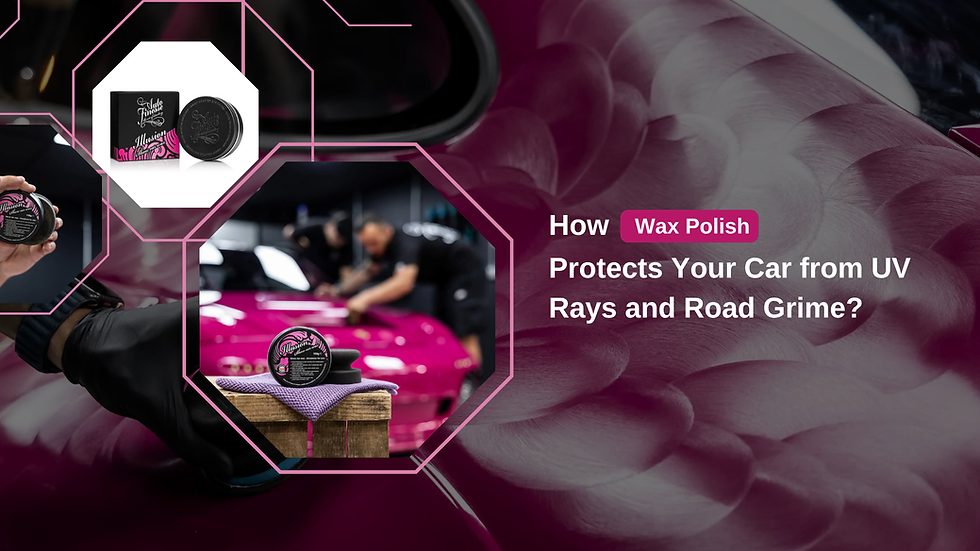Defend Your Rims with Ceramic Wheel Coating: The Only Guide You’ll Need!
- autofinesseuk
- Jun 19
- 4 min read
Updated: Jun 20
Are you tired of having to scrub away stubborn brake dust and road grime each time you wash your car? Are you looking for a way to keep your rims clean with little effort? Ceramic wheel coating might be exactly what you need. Far from being just another trend in car care, this advanced technology offers long-lasting protection and easier maintenance for your wheels.
In this in-depth guide, we will dive into the science behind ceramic wheel coatings, highlight their benefits, and explore what to look for in a high-quality product. Whether you are a professional detailer or a dedicated car enthusiast, this resource will help you understand how ceramic coatings can protect your rims and upgrade your car care routine.
Why Ceramic Wheel Coatings Are Worth Considering for Your Vehicle?
Ceramic wheel coatings are advanced protective treatments made with silicon dioxide (SiO₂) — the same compound found in quartz and glass. When applied, they form a transparent, durable barrier that shields your wheels from everyday wear and environmental damage. Here’s a look at how they work and why they’re worth considering:
Hydrophobic Protection: These coatings repel water, causing it to bead and roll off the surface. As it works, it removes dirt and grime, eliminating water stains and making cleaning easier. Similar to ceramic car wax, this hydrophobic effect not only improves the look of your wheels but also makes maintenance more efficient.
Oleophobic Barrier: Brake dust, road grime, and greasy residues can cling stubbornly to wheels. Ceramic coatings resist these oily contaminants, preventing buildup and making your wheels easier to maintain.
Chemical Resistance: Car ceramic coating offers excellent protection against harsh contaminants. When applied to wheels, it shields them from corrosive substances like brake dust, road salts, and acidic wheel cleaners, minimising the risk of staining, etching, and long-term corrosion.
Heat Resilience: Wheels are exposed to intense heat during braking. A quality ceramic coating can endure high temperatures without degrading and maintain its protective performance.
Long-Lasting Protection: Unlike waxes or sealants that wear off quickly, ceramic coatings bond at the molecular level with the wheel surface, offering durable, long-term protection that can last months or even years with proper care.
Self-Cleaning Properties: Thanks to their smooth, non-stick surface, dirt and grime are less likely to adhere, keeping wheels cleaner for longer and reducing the need for harsh scrubbing.
Better Finish: Beyond protection, ceramic coatings add a glossy, rich finish that improves the appearance of your wheels, making them look freshly detailed with little effort.

The Application Process: Preparation Is Everything
When applying ceramic wheel coating, preparation is crucial. In fact, the majority of your success — about 90% — comes down to how well you prep the surface. Wheels are constantly exposed to brake dust, road grime, and other stubborn contaminants, so proper cleaning and decontamination are important. Just like car ceramic paint protection relies on a clean, smooth surface for optimal bonding, wheel coatings also demand thorough prep to ensure long-lasting performance and protection.
Here’s a step-by-step analysis of the process:
1. Complete Cleaning
Begin by washing the wheels with a pH-neutral wheel cleanser. Use wheel and detailing brushes to clean tight areas and remove surface-level dirt and brake dust.
2. Iron Decontamination
Next, apply an iron remover to dissolve embedded brake dust and iron particles. The product will usually turn purple or red as it reacts. Rinse well to remove all residues.
3. Tar Removal (If Needed)
If you spot any tar deposits, use a tar and adhesive remover to break them down before moving on.
4. Clay Bar Treatment
Use a clay bar or clay mitt to remove any remaining bonded contaminants from the wheel surface. This step guarantees a smooth, contaminant-free base.
5. Polishing (Optional but Beneficial)
If your wheels have visible swirls, oxidation, or light scratches, polishing them will enhance gloss and help the coating bond better to the surface.
6. Panel Wipe / Surface Prep
Wipe the wheels with isopropyl alcohol (IPA) or a dedicated panel wipe to eliminate any leftover polishing oils or residues. This ensures a clean, bare surface ready for coating.
7. Applying the Ceramic Coating
Following the manufacturer’s instructions, apply the ceramic coating to an applicator pad. Work in small sections, covering all visible parts of the wheel faces, barrels, and even callipers if desired.
8. Levelling or Wiping Off Excess
Allow the coating to flash (typically a few minutes), then gently wipe away any excess using a clean microfibre towel.
9. Curing Time
Let the coating cure in a dry, dust-free environment for at least 24–48 hours. During this period, avoid water contact to ensure proper bonding and durability.
Final Note: Consider Investing in Wheel Protection Today
Ceramic wheel coatings are a smart investment for anyone who wants clean, well-protected wheels while cutting down on maintenance. Compared to traditional waxes and sealants, they provide stronger protection, easier cleaning, and a glossier, longer-lasting finish, much like the benefits of a high-quality ceramic car polish for your paintwork.
By understanding how ceramic coatings work and how to apply them correctly, you’ll be better equipped to choose the right solution for your vehicle. The result? Less time spent scrubbing and more time enjoying spotless, gleaming wheels.
Say goodbye to stubborn brake dust and hello to low-maintenance shine that lasts.


